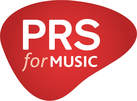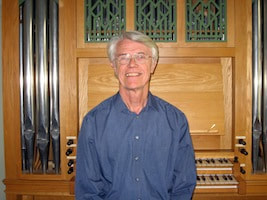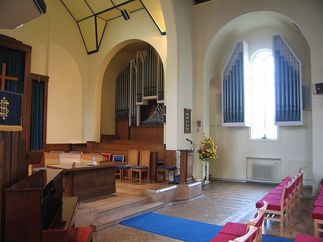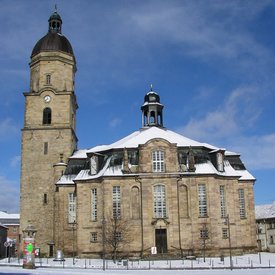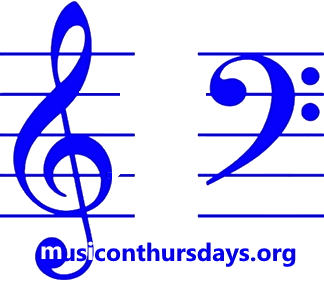Programme
Grayston Ives (b1948)
Intrada (1977) Johann Sebastian Bach (1685-1750) Chorale Partita Sei gegrüßet, Jesu gütig I greet Thee, merciful Jesu BWV 768 (1708-1713, or earlier) 1 Chorale 2 Variation I (a 2 Clav) 3 Variation II 4 Variation III 5 Variation IV 6 Variation V 7 Variation VI 8 Variation VII (a 2 Clav e Ped) 9 Variation VIII 10 Variation IX (a 2 Clav e Ped) 11 Variation X (a 2 Clav e Ped) 12 Variation XI (a 5 voci, in Organo pleno) Louis Vierne (1870-1937) from Vingt-quatre pièces en style libre Op 31 (1913-1914) 17 Lied (1913) Charles Villiers Stanford (1852-1924) from Six Short Preludes & Postludes Op 105 (1908) VI Postlude in D minor (1908) Concert duration: 45 minutes |
Free Concert, with a retiring collection to cover costs. Tea and coffee will be available after the concert.
Programme Notes
|
Intrada (Grayston Ives, born 1948)
Written for the Queen’s Silver Jubilee Thanksgiving Service in St Paul’s Cathedral on 7th June 1977, brilliantly evoking the coronation music styles of Parry and Walton. “Bill” Ives studied music at Cambridge, and composition with Richard Rodney Bennett. He taught at Reed’s School in Cobham, sang in Guildford Cathedral Choir, and then sang alongside Brian Kay in the King’s Singers between 1978 and 1982. He later directed the choir at Magdalen College, Oxford. Sei gegrüsset, Jesu gütig (JS Bach, 1685-1750) Chorale: four-part harmonisation in hymn singing style. (Pedals are needed in the last phrase.) 1 The first six variations are for manuals only: no 1 is an extended “bicinium” (2-part), with ritornello-like left hand and decorated chorale melody in the right hand. 2 On one manual, with running semiquavers and in up to 4 parts. The notes of the melody occasionally break up into semiquavers. 3 Right-hand semiquavers, left-hand quavers: the melody is only hinted at. 4 Melody in the soprano (until the final phrase). Semiquavers run throughout the other parts, with persistent repetitions of a characteristic 3-note figure. 5 Melody in the soprano, with a repeated rhythmic pattern in the left hand. 6 In 12/8 time: a new rhythmic figure moves between all four voice-parts. 7 The last five variations all have a pedal part: no 7 is a trio-sonata movement with the two hands imitating each other. The melody is in the pedals. 8 In 12/8 time (written as 24/16) with running semiquavers passing between the hands, and a staccato bass like a plucked stringed instrument. The melody is in the top part except when it has semiquavers. The movement ends with a 3-bar coda. 9 Another trio-sonata movement. The melody is on a 4-foot pedal stop sounding at alto pitch, so the left hand becomes the bass instrument. There is a short coda at the end here too. 10 An extended chorale, like many cantata movements, where each vocal phrase, represented by a solo stop, is introduced by the accompanying ensemble. At the fifth phrase of the chorale, the solo becomes a duet. This, the longest movement, balances no 1 in the overall arch-like structure. 11 “Organo pleno”— full organ, five-part harmonisation of the chorale, balancing the opening chorale. Lied (Louis Vierne, 1870-1937) No 17 from 24 Pieces in Free Style, all written for harmonium, but more often played on a full-sized pipe organ using two manuals and pedals. “Lied”, the German word for “song”, suggests that this is like a romantic song for baritone voice. Vierne’s chromatic harmony is recognisably French, often reminding us of Debussy. Postlude in D minor (Charles Stanford, 1852-1924) Probably the finest of Stanford’s short preludes and postludes written for church organists, the Postlude in D minor begins with a grand statement of the ten-bar chordal theme. The second theme, which is modal in character, begins in the pedals in A major, but soon makes its way back to D minor, and a return to the opening material, through a series of chromatic shifts. The lyrical middle section, in D major, develops the theme of the second section that leads into a link-passage incorporating a re-working of the initial statement in the major, over a dominant pedal. This, in turn, modulates back to D minor and the appearance of a heavily-embellished and extended recapitulation of first section. |
Anthony Cairns
|
Anthony Cairns has been organist and choirmaster at Christ Church, Leatherhead, since 1965. He has appeared as soloist with the Surrey Philharmonic Orchestra in organ concertos by Handel and Poulenc.
Anthony studied piano teaching, cello, and choir training at the Royal College of Music and holds degrees in law (Cambridge, 1961) and music (London, 1977). Anthony became Head of Music at Esher College in 1977, and taught academic music at the Purcell School from 1987 until 1997. He was conductor of Leatherhead Choral Society from 1991 to 2000. In 2006 he formed the Leatherhead chamber choir AntiphoniA, with whom he has given 17 concerts. In addition to his work at Christ Church, Anthony sings bass at St Peter’s Church, Vauxhall, and is Programme Director for this series of organ recitals. |
Anthony Cairns, pictured with his house organ
|
|
The Christ Church organ was built by Hill, Norman & Beard in 1970 with 16 stops, using some pipes from previous organs plus some neo-baroque sounds typical of the 1960's and '70's (Chimney Flute and Fifteenth on open-foot voicing, like the Royal Festival Hall organ). In 1995, HNB moved some loud stops from the Great to a new double case in the nave, 6 stops were added, and the tone was refined. In summer 2015 the nave organ was re-voiced to produce a more robust tone. |
Concert at Home:
Here are some links to online recordings of works that feature in Anthony Cairns' concert:
Here are some links to online recordings of works that feature in Anthony Cairns' concert:
For our opening recording we hear the first London-built Hill & Son organ ever sent to an Australian Church. Anglican Christ Church, St Kilda, Melbourne, is the city's earliest surviving church building,
dating from 1854-1857. The organ was built in 1859 and inaugurated in 1860.
It was restored by local firm Stewart Pipe Organs between 2006 and 2013.
In Grayston Ives' Intrada we hear Sydney organist David Tagg.
dating from 1854-1857. The organ was built in 1859 and inaugurated in 1860.
It was restored by local firm Stewart Pipe Organs between 2006 and 2013.
In Grayston Ives' Intrada we hear Sydney organist David Tagg.
We now come to the major work of this month's organ recital, Bach's Chorale Partita on Sei gegrüßet, Jesu gütig. We first hear the Chorale, and then 11 individual variations, some of which are marked for two manuals, or for 2 manuals plus pedals. The 11th variation is 'for 5 voices, in Organo pleno'.
If you would like to follow the score, it can be found here on IMSLP
(just wait the 15 seconds if you are not a subscriber).
We shall hear the 1724-1740 (Tobias Heinrich Gottfried) Trost organ in the Evangelical Stadtkirche "Zur Gotteshilfe", in Waltershausen, Thuringia, Germany. Unusually, this, the largest organ of Bach's time, sits in the church's east gallery, above the altar and chancel. The organ's most recent restoration was undertaken by Orgelbau Waltershausen from 1995 to 1998.
Following the bee sequence in this video, organist John Scott Whiteley
makes his ominous, Hitchockian footsteps, entrance.
If you would like to follow the score, it can be found here on IMSLP
(just wait the 15 seconds if you are not a subscriber).
We shall hear the 1724-1740 (Tobias Heinrich Gottfried) Trost organ in the Evangelical Stadtkirche "Zur Gotteshilfe", in Waltershausen, Thuringia, Germany. Unusually, this, the largest organ of Bach's time, sits in the church's east gallery, above the altar and chancel. The organ's most recent restoration was undertaken by Orgelbau Waltershausen from 1995 to 1998.
Following the bee sequence in this video, organist John Scott Whiteley
makes his ominous, Hitchockian footsteps, entrance.
My search for a French performance of Louis Vierne's Lied led me to the church of St Godard, Rouen, and a little choir organ by Cavaillé-Coll, played here by Nicolas Pien:
Would you like to hear the piece on a larger instrument ?
Here is Arnaud Bahuaud on the Clicquot organ in St Roch, Paris. This organ was restored by Cavaillé-Coll, and this church also possesses a choir organ by that famous builder.
Here is Arnaud Bahuaud on the Clicquot organ in St Roch, Paris. This organ was restored by Cavaillé-Coll, and this church also possesses a choir organ by that famous builder.
For our final work today it seems appropriate to hear a Cambridge organ. So this is Stanford's Postlude in D minor, played by Organ Scholar Daniel Hyde, on the Harrison & Harrison organ in King's College Chapel:
We hope you have enjoyed your Concert at Home
|
Link to venue
details |
Crotchets & Quavers
SSATB Ensemble courtesy of the University of Chichester 10th May 2018 |
Capital Horns
4 French horn players courtesy of the Royal Academy of Music 24 May 2018 |
Wednesdays at
Christ Church 2018 check out this year's varied rota of organists |

